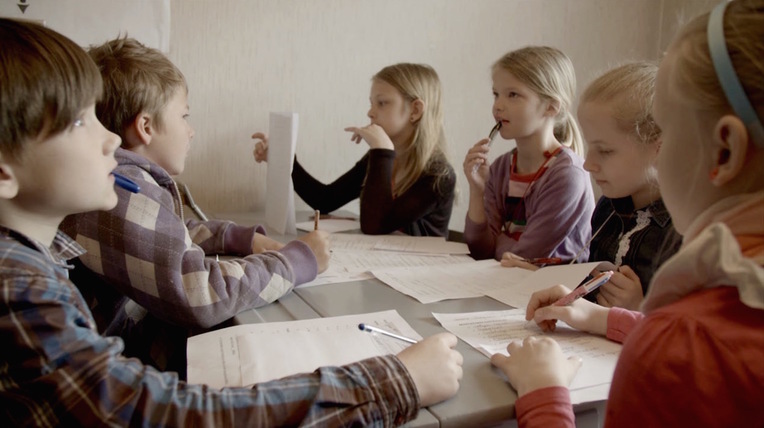“They know they can….”
|
|

Caption: Dana Narvaiša, eye to eye with students, guiding student decision-making.
I am putting together the agenda for my two-credit Democratic Workplace class at the University of Latvia. This will be the fifth time around; it starts February 11 and will include a mix of master’s degree students and practitioners, approximately 17 total.
As regular readers of Leading from the Middle know, I often refer to this class; it’s a blood relative of this blog. And, the students’ willingness to consider different ways of organizing, leading, and following, inspires me every time.
I try to add something new each session; #5 will have several new features including an assignment that uses a Latvian produced video, “'Think School' – Children in Charge” (Domāt skola),
by Krista Burāne with English sub-titles.
The production follows third graders at the New School in Cēsis, Latvia for two month as they self-organize and manage their end-of-school-year celebration. The children apply what they have learned in school, vote, decide, deal with conflict, and carry off their project, happily. I find “Think School” highly reminiscent of Kurt Lewin’s classic, if rudimentary, film on boys
clubs and leadership styles. “Domāt skola”, perhaps unknowingly, builds on Lewin’s ideas about democratic leadership and applies them in a real school setting.
Let me explain a little bit about Latvian schools. In Latvia, the first day of school - all over this northern European country of two million - is a dress-up festive day; students wear dresses and suits, and parents, also formally dressed, tag along. Teachers are presented with bouquets of flowers and boxes of chocolates.
Likewise, the end-of-the-school-year is a day of celebration for students, parents and teachers. Usually the event is organized, planned and directed by the teachers
The New School, led by Dana Narvaiša, turned the celebration’s organizing, planning and executing over to the students. Not without some uncertainty. At a point in the film one of the teachers asks the quintessential question: “Do we suggest them (program ideas). Or, let them decide on their own?” In other words, what does leadership look like when working with self-managing teams? How far does the leader let go? At what point does the leader intervene?
I want my students to view the video and to write a short paper on what they see.
I’ll provide a guide sheet with several questions from which to choose two or three for a written response. They’ll have the option to make up their own questions.
I wrote to Dana Narvaiša in hopes of getting her perspective on how this experiment in democracy went. She was kind enough to respond. Here are her slightly edited responses to a few of my questions:
Q. Do you think the self-management approach worked well, overall?
“This was our very first time we tried this approach in such a large scale, before we did small projects for one/two weeks. That is why we did a lot of mistakes. …
Must admit that I had higher expectations at that moment for our students, but now when more students have joined us from other schools, I see that our students from last year have higher skills of self management - they better plan their time, they know that they can make difference, they ask for help, search for solutions, set higher goals. Well, I do not like to compare students like this, but in this case it helps me really to see impact of our approach and I see that it worked quite ok.”
Q. Did most of the students do an equal amount of work or did some do more than others?

“... In reality I wouldn't say equal amount, but what I appreciated the most - they all were involved and they all overcame themselves. For me it is important that everyone has progress - for girls it looks different than for some boys. You can see K___ - who plays with balloon, gets angry and does not dance. At the beginning of the year he was (fighting with) everybody, was rude, had conflicts with all students and teachers, but at the end of the year - he is involved in everything, he asks to do work, he wants to be involved, he has initiative. There were discussions between kids - who does more, who less and it was good chance to talk about our differences….”
Q. Did the students learn from their mistakes?
“Well… they can tell in theory what were their mistakes and what they should do instead. But they have challenges with practical realization. We analyze almost every event and definitely every project, and they are really good in telling what worked, what didn't and what should be improved.” (Emphasis added.)
Q. What is the most important outcome from this adventure for the students?
“They know they can….”

© Copyright John Lubans 2016
 John Lubans - portrait by WSJ
John Lubans - portrait by WSJ